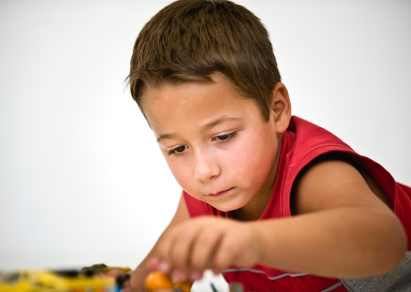By Wendy Harron - November 28, 2011
Can IM help a child with a TBI? YESS!!
Children who have a Traumatic Brain Injury typically go through a course of rehabilitation. It seems that although there are clusters of similarities in these patients, there are rarely ever 2 that exhibit the exact same difficulties after their injury. I met a 7 year old who had fallen off of a truck, and had suffered a TBI. He required surgery to repair a hole in his skull from the fall. This little guy received OT, PT and speech for a year in an intensive program and did very well. One year post his accident, he was demonstrating great recovery in every area – walking with no support or braces, cognitively intact and able to complete 1st grade work without assistance, speaking clearly and without difficulty. His last resulting effect was a left hemiplegia. His left arm dangled from his side and was non functional. This was very frustrating to him and to his family.
After a year of an intensive outpatient program, he was switched to a more typical outpatient service of 1x/week. I began to work with him, and saw his struggles. He had a hard time manipulating toys, which required 2 hands to be successful. One of his favorite activities prior to his accident was building with LEGO’s, but he now had difficulty putting pieces together without the use of his left hand. We did lots of exercises and sensory stimulation, but his progress continued to be very minimal. It seemed to be a struggle for this family to come to their sessions each week, but mom was committed to doing anything she could to help her son get better. After some discussion, and showing her some research, we decided that it would be a good time for him to try Interactive Metronome.
 He came 3x/week for 60 minutes each session, and he was a hard worker! Initially, he had to use his right hand to help move his left hand (clasped together) to reach for switches above his shoulders and to each side. We found that when his left arm was supported, that he started to be able to move his left thumb to hit a tiny switch – this took a lot of cognitive effort on his part, but he was able to gain more active movement after each IM session. I knew that we needed to get some index finger motion as well in order for him to have a functional pinch. So we utilized a finger splint to help give him some stability, and he started to move his index finger.
He came 3x/week for 60 minutes each session, and he was a hard worker! Initially, he had to use his right hand to help move his left hand (clasped together) to reach for switches above his shoulders and to each side. We found that when his left arm was supported, that he started to be able to move his left thumb to hit a tiny switch – this took a lot of cognitive effort on his part, but he was able to gain more active movement after each IM session. I knew that we needed to get some index finger motion as well in order for him to have a functional pinch. So we utilized a finger splint to help give him some stability, and he started to move his index finger.
After several weeks of treatment, mom reported that her son started to pick things up with his left hand! He was also able to get his arm into the sleeve of his shirt independently and was able to use his pinch to help tie his shoes by himself. We were able to work in some weight bearing positions, as now he was able to stabilize his elbow to get input throughout his left arm. For his home program, he was doing things like playing balloon volleyball, doing wheelbarrow walking and attempting to pinch open clothespins to pick up objects. She was excited that he was making gains so quickly! One of the impacts of IM is that because of the large amounts of repetitions, it helps to lay down strong, organized tracks in the brain. Because of his TBI, tracts had been interrupted, and new ones needed to be made. We were able to see him make one gain after another.
He still comes for more traditional OT 1x/week. His left shoulder strength and range of motion is within normal limits, and his elbow is very functional. He easily uses a thumb/finger grasp to pick up objects, and perform functional tasks. He and his mother agree that the intensive burst of IM really helped him to focus on individual movements, and concentrate on re integrating his left arm back into his every day skills. There are many ways in which IM can be helpful to those with TBI’s in both the adult and pediatric populations. Not only for range of motion tasks like I did with this little guy, but many cognitive, auditory processing and direction following tasks as well! It is such a flexible modality that can be incorporated into someone’s therapeutic program.

